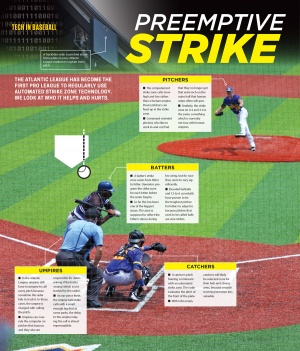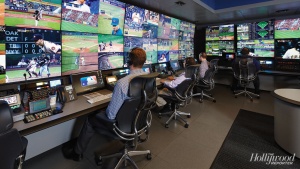Major League Baseball
Statistics are one of the most important parts of Major League Baseball (MLB) today. Technology continues to be used in baseball more often every year — both because of its usefulness and to counteract previous failures in the game, such as the stealing of signs and signals. The biggest question that many managers, players, and fans are asking today is whether technology is helping or hurting the integrity of the game of baseball.
Contents
The Question of Technology in Baseball
Some people blame technology for the recent cheating scandals in baseball, and claim it has no place in the game. Others fight for the implementation of new technologies in order to protect the honesty and accuracy of the game. There was a high in the fight for statistics and technology after the Oakland Athletics’s manager, Billie Beane, released his winning strategy book “Moneyball”. In the book, he explains how he used statistics and analytics to create a roster that shifted the odds of winning baseball games [1]. After the Houston Astros sign stealing scandal in the 2017 season and World Series Championship, managers are fighting for a complete removal of technology from baseball in order to take power away from “technocrats” and return to the original ways of baseball. People are wondering how to address both sides of the argument, to use technology to improve the game, but also keep the integrity of baseball.
Pro New Technology in Baseball
No matter what angle you approach baseball from, statistics are a key component in the creation of lineups, player development, and the comparison of players and teams. People who embrace technology advocate for including more robotic umpires in order to improve the accuracy of calling balls and strikes. Upon manager challenging, the MLB allows video replays for calls such as out and safe, or whether a ball is caught or not, but reviewing ball and strike calls is not an option. Leagues such as the Atlantic League are trying to take away human error in ball-strike calls by using Trackman, a radar-based system that can identify if a pitch is in the strike-zone or not — at the same speed that a human umpire can. This “3-D Doppler radar dish” analyzes thrown pitches using a three-dimensional strike-zone that can calculate each batter's size and stance and adjust the strike zone accordingly. The system works so that it doesn't allow a 6-foot-7 player to have the same strike zone as a 5-foot-7 player.[2] The ball or strike call is then transmitted to the human umpire through an earpiece, allowing the call to be made. Many argue that this takes the human aspect of the game away, but from its testing in the American League, many players, umpires, and coaches tend to like the new implementation.
Against New Technology in Baseball
Other new technology is beginning to enter the game of baseball in order to counteract the multiple cheating scandals in the MLB over the past five years, notably, the Houston Astros 2017 World Series Championship. Although many of the players involved in this scandal claim they did not wear buzzers under their jerseys in the 2017 regular or post-season games, there has been in-depth investigation into how the Astros stole the signs and signals of other teams, and alerted their batters on what pitches to expect. Stealing signs and signals is not illegal — in fact many see it as a fun part of the game — but using technology to steal them is highly illegal, which is what the Astros did. In the past, teams have used telescopes to steal signs, and other various amounts of loopholes. [3] The Astros used a video replay stream from center field and sent it to a television monitor behind their dugout. Then, Astros players would bang on a trashcan with a bat to alert the batter to expect a curveball, or changeup. If players didn't bang on the trashcan, batters expected a fastball. This implementation of technology in an unethical way lead the Astros to win the World Series. Due to the scandal, many players and managers now question the necessity of technology in the game of baseball. The Astros scandal caused a lot of uproar, especially after similar scandals occurred before, such as the Boston Red Sox using Apple Watches to steal pitches by communicating with people outside the dugout.
Ethics of the Code of Silence
After the Astros scandal came to light, there were no severe punishments given to the Astros players by the MLB commissioner. The MLB suspended the Astros general manager and manager for one year, and fined the team $5 million, but the team also won $31 million in bonuses for winning the World Series due to the scandal. All in all, the rewards outweighed the consequences. Due to this, protestors of technology in baseball believe that the MLB has problems with their code of ethics ingrained within its culture, and that the game could suffer unless something changes. [4] Mike Fiers, the Astros' pitcher, spoke up about the Astros' sign-stealing scheme, and has suffered consequences for doing so. Most likely, all Astros players, managers, and operations staff knew about the scam, but no one else spoke up to break the MLB's code of silence. The code of silence exists because few people within the MLB actually play by the rules. The code of silence has been used for years, through the steroids era and now when technology is used to cheat. Players don't report wrongdoings mostly because of fear that doing so would result in threats from players, MLB staff, and fans. Because of this, people continue to look the other way, raising serious ethical concerns. There is not a lot of benefit to breaking the code of silence either, because the MLB has not been known to hold unethical behavior accountable. [4] Furthermore, in recent years, there has been a decline in ethical behavior and an acceleration of improper conduct. [5] Due to this, after the Astros scandal, the MLB began to discuss how to limit player access to live video during games so that they can't steal signs and signals using technology. Those against the use of technology in baseball suggested to ban live video during games entirely, which is not likely. [6]
Conclusion
The biggest debate now is whether the implementation of technology will reverse or enhance these cheating trends. For example, teams are testing new ways for pitchers and catchers to communicate rather than using old fashioned signs and signals. This is in hopes of reducing the ability of teams stealing signs. Two of the most prominent methods are an earpiece worn by the pitcher and catcher that allows them to communicate without a mound visit, and a lighting system on the pitcher's mound that is controlled by the catcher. In the lighting system, the catcher presses a button activating the lights on the pitchers mound, which is only visible by the pitcher. The lights are coordinated with different pitch calls, allowing for a more private exchange of information between the pitcher and catcher. Another more advanced example is a wearable device that allows signs sent by the catcher to be encrypted, so it is almost impossible to decode the signs and signals.[7] Companies such as Apple and Fitbit are looking to bid to become the official wearable technology brand for the MLB in order to prevent sign-stealing.[8] These technologies, though innovative and impressive, bring up many ethical questions and concerns from the baseball community. With these new technologies come new ways to cheat. How soon before teams hire their own hacking professional to steal signs from earpieces or change the signs sent to the pitcher mid-encryption? Until this technology is tested and implemented in more games, many questions won't be answered, such as how the pace of the game will be affected, the loss of human interaction, and coaches implementation in games. There will always be a place for technology in baseball, but will that place always be an ethical one that improves the integrity of the game? People advocating for complete technology blackouts are most likely never going to see that happen, because technology is taking over all aspects of the world. America’s pastime is being threatened by technology the same way it was by steroids, it won’t kill the sport but it could cause a weakening of the fanbase.
References
- ↑ Boylan, Mike (3 October 2017). “‘Moneyball’ and the Oakland A's: How Has It Been so Misunderstood?” Bleacher Report
- ↑ Acquavella, Katherine (27 August 2019) “Robot Umpires: How It Works and Its Effect on Players and Managers in the Atlantic League, plus What's to Come.” CBSSports.com
- ↑ Longman, Jeré (18 January 2020). “Technology Throws a Curveball to a Sport Built on Deceit. Or Is It Gamesmanship?” The New York Times
- ↑ 4.0 4.1 Miles, John R., and Kira Gochuico (13 March 2020). “Major League Problem – From Code of Silence to Code of Ethics.” Bold Business
- ↑ Kastel, Matthew, and Jordan Kobritz (24 April 2015). "What Baseball Can Teach Us About Ethics" Complianceandethics.org
- ↑ Abraham, Peter (25 February 2020). “Technology's Effect on Baseball Is a Huge Concern for MLBPA Head Tony Clark - The Boston Globe.” BostonGlobe.com, The Boston Globe
- ↑ Axisa Mike (6 January 2020), “MLB Exploring Ways to Use on-Field Technology to Help Prevent Sign-Stealing, Report Says.” CBSSports.com
- ↑ Vigdor, Neil (14 January 2020) “The Houston Astros' Cheating Scandal: Sign-Stealing, Buzzer Intrigue and Tainted Pennants.” The New York Times, The New York Times

